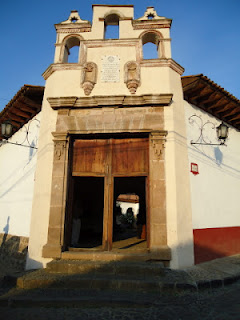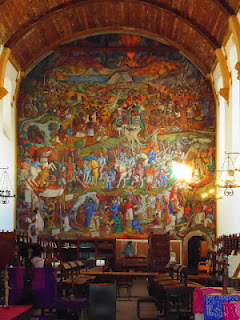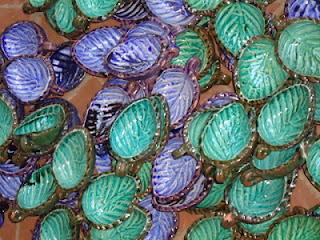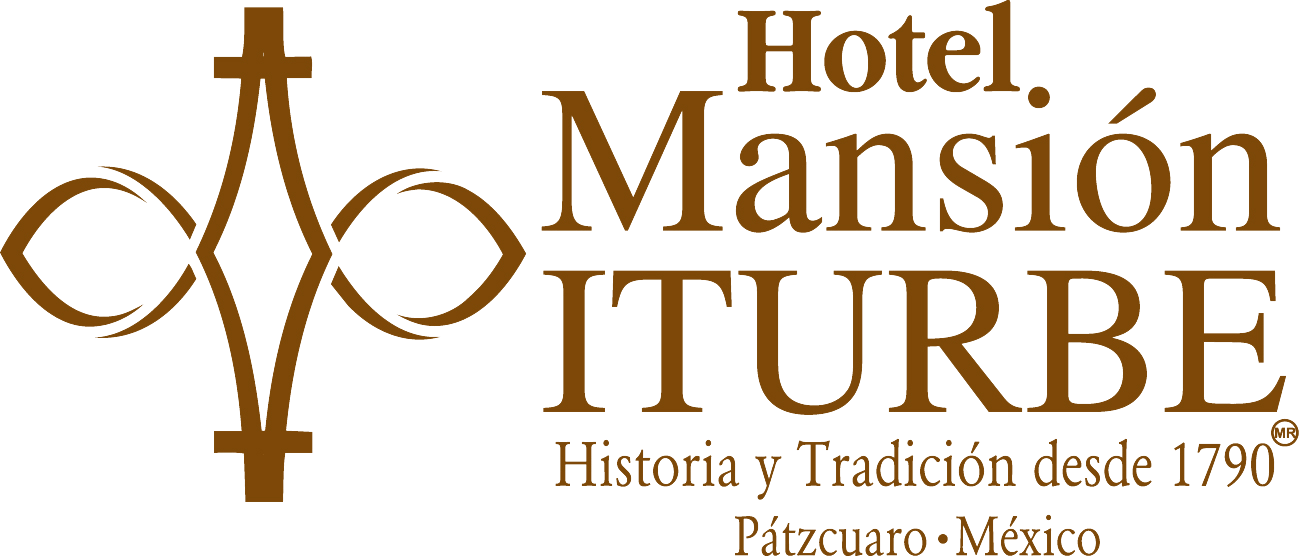10 Must-Sees in Patzcuaro
Besides being a very “typical” Mexican village, Patzcuaro
is also one of the most lovely villages in the entire country. And our hotel in Patzcuaro, Mansion Iturbe,
is right in the center of it all. From
our front door, you have access to all ten of the following destinations – on foot – in just a matter of minutes.
 |
| Vasco de Quiroga Square in Patzcuaro |
La Plaza Vasco de Quiroga (“La Plaza Grande”)
Considered one of the most beautiful plazas – or
“squares” – in the country, it measures about 600 by 450 feet . The central
square of Pátzcuaro is unique in an unusual aspect: There are no churches on its perimeter! The famous Basilica and other temples are not
even visible from the Plaza.
Instead, La Plaza Vasco de Quiroga is surrounded by
“civilian” – or once residential – structures of Boroque and Neoclassical
architecture which, along with the gigantic trees surrounding the Plaza, come
together to create the majesty of the space.
The centerpiece of the Plaza is a finely executed fountain of the adored
Don Vasco de Quiroga.
 |
| Vasco de Quiroga Square from Hotel Mansion Iturbe in Patzcuaro |
One of those buildings is none other than the Hotel Mansión Iturbe – a significant part of Mexican history, once the home of the
famous conspirator Don José María Abarca.
During the
ninteenth and twentieth centuries, this corner, where you will find a plaque commemorating 200 years of Planned Business, had a vital link in the
economic life of this Magic Village.
 |
| Portal Morelos in Pátzcuaro, where Hotel Mansion Iturbe is located |
Later, it became the House of Trade and (Mule)
Delivery, with owner Don Francisco de Iturbe y Heriz. His claim to fame in that era was his ability
to establish the connection with Acapulco, whence came all varieties of
merchandise from the Philipines and China typically in Spanish fleets: “The Chinese Fleet.”
This Pacific fleet operated between Acapulco and
Manila transporting passengers and all sorts of merchandise. Once on Mexican soil, the merchandise was transported
by mule. New Spain was the link between Asia and Europe. Later, merchandise was sent from Veracruz to
Spain using the Indian Fleet, crossing the Atlantic Ocean.
 |
| Interior of Hotel Mansion Iturbe in Patzcuaro |
In 1970, this building was restored, maintaining its
historical integrity as a Gem of New Spain Architecture. In that year, the building opened its doors
as Hotel Mansión Iturbe.
2. Museo Regional (Museum)
Patzcuaro’s museum, located two blocks from Hotel
Mansión Iturbe, which has recently undergone a major restoration. You mustn’t miss the Museum!
 |
| Regional Museum in Patzcuaro |
Established in the sixteenth century by Don Vasco de Quiroga, it was originally the Royal College of San Nicolás. The college was later moved to Valladolid
(today Morelia), and the building in Patzcuaro went into the hands of the
Jesuits. The building was put to several
other uses until 1938 when then-President Lázaro Cárdenas officially proclaimed
it the museum that we have today.
The focus of the Museum is arts and crafts of the
regional Purépecha, encompassing about 50 neighboring communities.
If you go to the back of the museum, outside, you will see the top of an
actual ancient Purépecha pyramid.
In the spacious rooms, you will see the laquerware,
textiles, embroidery, claywork, musical instruments, and other artesanwork –
the pride of the Purépechas.
3. Basílica of Our Lady of Health
Listen to the haunting sound of the huge bronze bells
of the Basílica (that can be heard from just about anywhere in Pátzcuaro), and
visit this monument so representative of Pátzcuaro; it is but a few blocks from
Hotel Mansión Iturbe.
 |
| Basilica of our Lady of Health in Patzcuaro |
The construction of the Basílica dates from the epoch
of Don Vasco de Quiroga (1543). Don
Vasco wanted a grand cathedral with five naves, but Don Vasco’s dream was never
realized. Only the central nave was
constructed. In 1580, the title of “cathedral”
was transferred to Valladolid (today Morelia), and the structure became a
“parroquia,” which title stuck until 1924, when it was elevated to “basílica.”
These days, countless believers from all over Mexico
and distant parts of the globe come to Pátzcuaro throughout the year to visit our Lady of Health.
4.
Public Library (Ex Convent of Saint Agustín)
La Biblioteca Pública Gertrudis Bocanegra (Public
Library) can be seen from the Calle-de-Iturbe side balconies of Hotel Mansión
Iturbe, in the historical downtown of Pátzcuaro.
It dates from 1576 and was an Augustinian
convent. In 1860, this large building
went into secular use, and in 1882 the government of Michoacán sold the
property. In 1938, General Lázaro
Cárdenas ordered that it be converted into the public library – la Biblioteca
Pública Gertrudis Bocanegra.
 |
| Juan O'Gorman Mural at the Public Library in Patzcuaro |
Here you see the HUGE, famous mural of Juan O’Gorman,
which records the history of Michoacán from pre-Colombian times through the
Mexican Revolution.
5.
Casa de los Once Patios
At a short distance from Hotel Mansión Iturbe, you will find Casa de los Once Patios. It’s the
place to go to find artisanware of Pátzcuaro and the basin area. Visit the artisans on site with their table
cloths, napkins, detailed lacquerware, and much more. Definitely an artisan-lover’s must-see.
 |
| Casa de los Once Patios in Patzcuaro |
Today, there are actually only five patios that make
up the artisan complex, which was once a nunnery. Enjoy the lovely architecture and explore the
old patios and find a great variety of artisanware that has made Pátzcuaro a
shopper’s Paradise.
One of the most beautiful images – and one of the most
representative of Pátzcuaro – is the Templo del Sagrario, built in the
Seventeenth century. Don Vasco de
Quiroga was responsible for getting the construction started, but it took two
centuries to complete. It was originally
the Santuario la Virgen de la Salud de Pátzcuaro, until it was transferred to
the Basílica in 1908. The
boroque altar is stunning.
 |
| Templo del Sagrario in Patzcuaro |
7. Ex Colegio
Jesuita and Templo de la Compañía
During your visit, check out the billboard of events
at the Ex Colegio Jesuita (ex Jesuit college).
The art shows are changing constantly, and concerts are regularly held
in the small auditórium downstairs. It’s
just two block from the Hotel Mansión Iturbe!
The Jesuits ran the Colegio de San Ignacio until 1767
– the year they were expelled from New Spain.
The building had various uses and was eventually abandoned. Only in 1990, citizens spearheaded the
revitalization of the building, which was totally restored in 1994. In 2003, the Secretary of Culture took over
and established it as the Cultural Center.
 |
| Ex Jesuit College in Patzcuaro |
At the south end of the Colegio, we find the lovely
Templo de la Campañia, built in
the 16th century. It served as the
provisional cathedrel (Catedral de San Salvador) until 1566.
8. La Plaza
Gertrudis Bocanegra (La Plaza Chica)
Located one block north of the Plaza Vasco de Quiroga
and the Hotel Mansión Iturbe, this plaza is the second-most-important plaza in
Pátzcuaro. Long ago, it was the site of
the Cloister of the Templo de San Agustín.
It is named after the heroine of Independence, Doña Gertrudis Bocanegra, who was originally from
Pátzcuaro. In the center of the plaza is
a large bronze status of her.
 |
| Gertrudis Bocanegra Square in Patzcuaro |
9.
Sanctuary of Guadalupe
This is an excellent example of nineteenth-century
neoclassical architecture. From its tall
tower, we can see four figures representing Moderation, Charity, Strength, and
Faith. Don Feliciano Ramos ordered the
structure build to fulfill a promise to the Virgin of Guadalupe to replace a
chapel built in the seventeenth century.
 |
| Sanctuary of the Virgin of Guadalupe in Patzcuaro |
10. La Plaza de San Francisco
The Pottery Market is held every Friday morning at the
Plaza de San Francisco. You can’t miss
this event, where you will find pottery from the different communities around
the lake.
 |
| Pottery Market at San Francisco Square in Patzcuaro |
* * *
These are only some of the most representative areas
in Pátzcuaro we recommend that you visit.
Pátzcuaro is a place to enjoy and immerse youself in the diversity of
our cultures and identities.
Finally, give yourself time to delight your palate and
discover traditional Michoacán cuisine and the Mexican Cuisine which has been declared a National
Heritage by UNESCO. And it’s available
in Restaurante Doña Paca in the
Hotel Mansión Iturbe, facing the Plaza Vasco de Quiroga itself.
On your next trip to Pátzcuaro, discover why it is
considere one of the loveliest Typical Towns in Mexico, with these ten
must-see places, all within a stone’s throw of Mansión Iturbe.
*Text and Pictures Property of Hotel Mansión Iturbe.
We invite you to check more post in our blog, you will find information that we hope will be useful for your next trip to Pátzcuaro. Here are some post that we recommend you to check:
Day of the Dead in Pátzcuaro
Palm Sunday in Patzcuaro, the beginning of Holy Week
Festival of Corpus Christi in Patzcuaro
We invite you to check more post in our blog, you will find information that we hope will be useful for your next trip to Pátzcuaro. Here are some post that we recommend you to check:
Day of the Dead in Pátzcuaro
Palm Sunday in Patzcuaro, the beginning of Holy Week
Festival of Corpus Christi in Patzcuaro
Hotel Mansion Iturbe
Portal Morelos 59
Plaza Vasco de Quiroga
61600 Patzcuaro, Mich.
MEXICO
Tels: +52 (434) 342 0368 / 342 3628
Fax: +52 (434) 342 3627
Toll free fax number from USA & CANADA: 1-866 678 6102
For more information from our hotel in Patzcuaro: www.mansioniturbe.com
Amadeus: ON MLMMAN
Sabre: ON 16297
Galileo: ON 24977
Worldspan: ONMLMM
Sabre: ON 16297
Galileo: ON 24977
Worldspan: ONMLMM










Comentarios